|
Rod and Reel
Jump to;
Lures |||
Bait and tackle
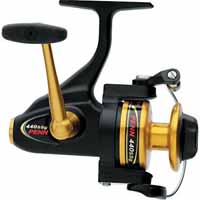  To
fish for the most popular game fish
species in the Indian River Lagoon, a
good quality basic spinning outfit for
8-12 lb test line will work just fine.
My favorite is a seven foot medium
action rod with a spinning reel holding
about 200 yards of line. I use a
Shakespeare Ugly Stik Intracoastal
graphite spinning rod, 7 foot, medium
action, and rated for 6 to 12 lb test
line. I have always been a fan of Ugly
Stiks because even though the rod's
action is listed as "medium", the tip
has a lighter action for more
sensitivity when casting lightweight
lures such as un-weighted soft plastic
lures or freelined live shrimp. For a
reel, any good quality spinning reel
capable of holding about 200 yards of
whatever LB test of line you wish to use
will work just fine. I use a Penn
Spinfisher model 440 SSG. It is rated
for 8 to 12 LB test and will hold about
200 yards of 10 LB test mono. For
fishing line, there are lots of options.
Stren, Ande and Trilene all make good
products. I use 8 LB test because it
increases the line capacity of my reel
to about 240 yards, and with it I can
cast lighter lures and baits easier and
farther. I used to never use a leader
unless I was specifically targeting
snook or tarpon. However, when fishing
for reds and seatrout, you never know
when the fish striking your brand new
$5-$10 lure will be a snook, tarpon,
ladyfish, or a jack crevalle, which will
cut through your line in a heartbeat.
I've lost enough lures to now
recommend use of a leader at all times,
so I also carry a small spool of 25 LB
test fluorocarbon leader material and
tie about 2 ft of this with an albright
special knot to the end of my fishing
line to protect against cutoffs. Wire
leaders with swivels on one end and a
snap on the other for attaching hooks
and lures are also available, however,
in my opinion they are way too visible
to the fish and will drastically cut
down on the number of fish that will
strike your bait. To
fish for the most popular game fish
species in the Indian River Lagoon, a
good quality basic spinning outfit for
8-12 lb test line will work just fine.
My favorite is a seven foot medium
action rod with a spinning reel holding
about 200 yards of line. I use a
Shakespeare Ugly Stik Intracoastal
graphite spinning rod, 7 foot, medium
action, and rated for 6 to 12 lb test
line. I have always been a fan of Ugly
Stiks because even though the rod's
action is listed as "medium", the tip
has a lighter action for more
sensitivity when casting lightweight
lures such as un-weighted soft plastic
lures or freelined live shrimp. For a
reel, any good quality spinning reel
capable of holding about 200 yards of
whatever LB test of line you wish to use
will work just fine. I use a Penn
Spinfisher model 440 SSG. It is rated
for 8 to 12 LB test and will hold about
200 yards of 10 LB test mono. For
fishing line, there are lots of options.
Stren, Ande and Trilene all make good
products. I use 8 LB test because it
increases the line capacity of my reel
to about 240 yards, and with it I can
cast lighter lures and baits easier and
farther. I used to never use a leader
unless I was specifically targeting
snook or tarpon. However, when fishing
for reds and seatrout, you never know
when the fish striking your brand new
$5-$10 lure will be a snook, tarpon,
ladyfish, or a jack crevalle, which will
cut through your line in a heartbeat.
I've lost enough lures to now
recommend use of a leader at all times,
so I also carry a small spool of 25 LB
test fluorocarbon leader material and
tie about 2 ft of this with an albright
special knot to the end of my fishing
line to protect against cutoffs. Wire
leaders with swivels on one end and a
snap on the other for attaching hooks
and lures are also available, however,
in my opinion they are way too visible
to the fish and will drastically cut
down on the number of fish that will
strike your bait.
Lures
Jump to;
Bait and Tackle |||
Back to Top
Now this is a subject matter that you
will be hard pressed to get a consensus
among anglers on. Every one I know has
their own personal favorites and the
only conclusion I can come to is that
there are a lot of lures that will at
least occasionally catch a fish.
Unfortunately every lure manufacturer
around claims that theirs is the best.
It can get real confusing for a newcomer
to try and make a good selection. The
following list and photo below is not an
all encompassing list as there may be
lures on the market that may perform as
well if not better on any given day.
What I can say is that lures listed and
in the photo have produced for me. This
list is designed to get a beginning
angler started with a reasonable chance
of catching fish in the waters he is
most likely to have access to, publicly
owned shorelines and docks. They will of
course work even better if and when you
get a boat or kayak and can explore the
lagoon to a greater extent.
One last note before we continue; I
never use a snap swivel to attach any of
the lures listed below to my line with
the exception of the Johnson's Silver
minnow Spoon, which requires one because
it will twist your line if you don't. I
always use a Loop Knot such as a
Rapala Knot or a Mirrolure Knot, as a
loop knot will allow your lure to
produce it's maximum designed action. A
hard tied knot such as an improved
clinch knot will retard much of your
lure's action.
We will start at the top of the water
column.
 Surface
Walkers; This class of lures is very
popular especially in the spring and
summer when there are lots of finger
mullet in the lagoon and can bring
explosive strikes from redfish, trout,
snook and tarpon on the expansive grass
flats. A steady retrieve incorporating a
twitching action with the rod tip will
produce a zig zag pattern on the surface
of the water called "walking the dog".
These can be used in very shallow water
as they will only submerge if you reel
them in too fast. This class of lures is
represented by Heddon's Zara Spook
series, Mirrolure's Top Dog series,
Rapala's Skitterwalk series and several
other manufacturers. They also come in a
variety of sizes with the larger
versions designed primarily for "trophy
fish". If you have a boat and can access
more remote flats and cover more water,
by all means try the larger versions. If
you are just starting out, or most of
your fishing is shoreline and docks, go
with the smaller versions. More fish
will hit them and the hookup ratio will
be higher. One that I am very impressed
with is a fairly recent addition to
Mirrolure's line of surfae walkers is
the
MirroMullet model # 16MR-21. This
lure very closely resembles a juvenile
finger mullet and is a great lure for
early morning flats surface action. Surface
Walkers; This class of lures is very
popular especially in the spring and
summer when there are lots of finger
mullet in the lagoon and can bring
explosive strikes from redfish, trout,
snook and tarpon on the expansive grass
flats. A steady retrieve incorporating a
twitching action with the rod tip will
produce a zig zag pattern on the surface
of the water called "walking the dog".
These can be used in very shallow water
as they will only submerge if you reel
them in too fast. This class of lures is
represented by Heddon's Zara Spook
series, Mirrolure's Top Dog series,
Rapala's Skitterwalk series and several
other manufacturers. They also come in a
variety of sizes with the larger
versions designed primarily for "trophy
fish". If you have a boat and can access
more remote flats and cover more water,
by all means try the larger versions. If
you are just starting out, or most of
your fishing is shoreline and docks, go
with the smaller versions. More fish
will hit them and the hookup ratio will
be higher. One that I am very impressed
with is a fairly recent addition to
Mirrolure's line of surfae walkers is
the
MirroMullet model # 16MR-21. This
lure very closely resembles a juvenile
finger mullet and is a great lure for
early morning flats surface action.
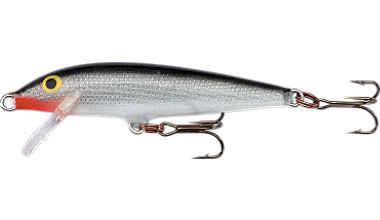 Floater / Diver; Rapala Original
Floating Minnow Model F09 If I were
told that I had to fish with one and
only one surface plug for the rest of my
life, I would choose Rapala's original
floating minnow. First hand carved in
the 1930s out of balsa wood by a Finnish
Commercial Fisherman named Lauri Rapala
it launched an industry. It is a very
simple lure to use. Cast it, let it
settle on the surface, and then twitch
it so that it dives just beneath the
surface, let it resurface, and repeat.
If you are not catching anything after a
bit and you have enough clearance
between the surface of the water and the
bottom, about two to three feet, just
cast and reel with a steady retrieve.
This has worked for me more than once.
They come in a variety of sizes and
colors. I carry two with me, both of
them 3 1/2 inches long, one in silver,
and one in gold, and I recommend both of
them. Use the silver in cleaner water,
the gold in water of lesser clarity, but
if you are buying only one, get the
silver.
Floater / Diver; Rapala Original
Floating Minnow Model F09 If I were
told that I had to fish with one and
only one surface plug for the rest of my
life, I would choose Rapala's original
floating minnow. First hand carved in
the 1930s out of balsa wood by a Finnish
Commercial Fisherman named Lauri Rapala
it launched an industry. It is a very
simple lure to use. Cast it, let it
settle on the surface, and then twitch
it so that it dives just beneath the
surface, let it resurface, and repeat.
If you are not catching anything after a
bit and you have enough clearance
between the surface of the water and the
bottom, about two to three feet, just
cast and reel with a steady retrieve.
This has worked for me more than once.
They come in a variety of sizes and
colors. I carry two with me, both of
them 3 1/2 inches long, one in silver,
and one in gold, and I recommend both of
them. Use the silver in cleaner water,
the gold in water of lesser clarity, but
if you are buying only one, get the
silver.
 Krocodile
Spoon by Luhr Jensen,3/8 ounce, model
1003; If I were told that I could
fish with only one lure of any kind it
would be a close contest between the
spoon and the jig. While the Johnson
Silver Minnow below is better known in
the area, I feel that the Krocodile with
it's trailing treble hook has an overall
better hookup ratio. I use this whenever
possible and in the chrome finish has
been my go to lure for searching for
schools of seatrout on two to three foot
deep flats or around docks and seawalls
for over 30 years. It is also a great
lure for light tackle bluefish and
spanish mackerel fishing in the surf.
Another advantage is that with a
properly spooled reel you can cast these
things a mile. My all time favorite lure
when fish are attacking baitfish in the
lagoon and will catch anything that eats
small fish. Cast and retrieve while
providing a pulsating action with the
rod tip. I ahve also caught trout from
under docks by being very quiet on the
dock and jigging this lure straight up
and down. Now if the water is shallower
and there is lots of grass I will switch
to............ Krocodile
Spoon by Luhr Jensen,3/8 ounce, model
1003; If I were told that I could
fish with only one lure of any kind it
would be a close contest between the
spoon and the jig. While the Johnson
Silver Minnow below is better known in
the area, I feel that the Krocodile with
it's trailing treble hook has an overall
better hookup ratio. I use this whenever
possible and in the chrome finish has
been my go to lure for searching for
schools of seatrout on two to three foot
deep flats or around docks and seawalls
for over 30 years. It is also a great
lure for light tackle bluefish and
spanish mackerel fishing in the surf.
Another advantage is that with a
properly spooled reel you can cast these
things a mile. My all time favorite lure
when fish are attacking baitfish in the
lagoon and will catch anything that eats
small fish. Cast and retrieve while
providing a pulsating action with the
rod tip. I ahve also caught trout from
under docks by being very quiet on the
dock and jigging this lure straight up
and down. Now if the water is shallower
and there is lots of grass I will switch
to............
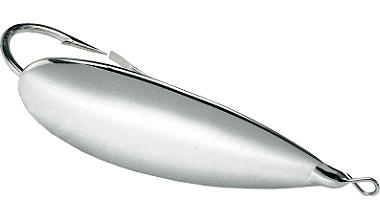 1/4
ounce, model SM1/4 Johnson's Silver
Minnow now marketed by Berkely
Fishing. In
gold color it is considered to be a
redfish standard. The Johnson's Silver
Minnow has a welded in single hook
weedless design that allows you to fish
it over very shallow water seagrass beds
without hanging up in the weeds. It can
also be bounced of the bottom in deeper
water. While the Krocodile has a swivel
attached to the front, the Johnson's
does not and the use of a snap swivel is
highly recommended. Again cast and
retrieve with a occasional twitch of the
rod tip. If you buy nothing else, get a
Krocodile in chrome, and a
Johnson's in gold. 1/4
ounce, model SM1/4 Johnson's Silver
Minnow now marketed by Berkely
Fishing. In
gold color it is considered to be a
redfish standard. The Johnson's Silver
Minnow has a welded in single hook
weedless design that allows you to fish
it over very shallow water seagrass beds
without hanging up in the weeds. It can
also be bounced of the bottom in deeper
water. While the Krocodile has a swivel
attached to the front, the Johnson's
does not and the use of a snap swivel is
highly recommended. Again cast and
retrieve with a occasional twitch of the
rod tip. If you buy nothing else, get a
Krocodile in chrome, and a
Johnson's in gold.
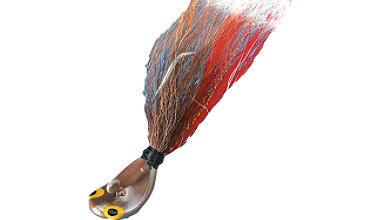 Jigs;
The good old bucktail or hair bodied
jig is probably the most overlooked lure
in the tacklebox,and probably one of the
best lures you own. The feather or
bucktails dressing on the jig produces a
lifelike "breathing" action with water
movement. I prefer these over soft
plastic swirley tailed jigs due to the
fact that when using soft plastics small
fish tend to attack the tails, severing
them and reducing the action of the jig.
Plus most of the action is behind the
hook. With the bucktails, the action is
at the hook. There are many different
types of jig heads, some are meant to be
fished deeper while others like the Salt
Wobbler Jig at left by Cabelas have a
head design that produces a wobble when
they sink, and are designed to be fished
in shallower water. These can work great
when casting toward mangroves, in
canals, along docks and seawalls. The
important thig to remember is to choose
the right style of jig and this can be
done by checking out the shape of the
head. A bullet shape head with the eye
for the line in the middle of the head
is designed more for jigging in deeper
water over some sort of structure.
Trying to use these in the lagoon
shallows will result in seagrass being
snagged. The arrowhead shaped heads
designed for bonefish jigs will work
well here as the shape of the head as
well as the line eye being mounted on
the from of the head indicated that
these are designed for casting and
retrieving. They will run shallower and
are less likely to be snagged on
submerged vegetation. Choose jigs in the
1/4 to 3/8 ounce range for best results
in the lagoon. effective colors can run
in msny combinations including brown to
imitate shrimp, chartreuse and white,
red head / white bodies, and pink. A
selection of jigs should always be
included in a lagoon tackle kit. Jigs;
The good old bucktail or hair bodied
jig is probably the most overlooked lure
in the tacklebox,and probably one of the
best lures you own. The feather or
bucktails dressing on the jig produces a
lifelike "breathing" action with water
movement. I prefer these over soft
plastic swirley tailed jigs due to the
fact that when using soft plastics small
fish tend to attack the tails, severing
them and reducing the action of the jig.
Plus most of the action is behind the
hook. With the bucktails, the action is
at the hook. There are many different
types of jig heads, some are meant to be
fished deeper while others like the Salt
Wobbler Jig at left by Cabelas have a
head design that produces a wobble when
they sink, and are designed to be fished
in shallower water. These can work great
when casting toward mangroves, in
canals, along docks and seawalls. The
important thig to remember is to choose
the right style of jig and this can be
done by checking out the shape of the
head. A bullet shape head with the eye
for the line in the middle of the head
is designed more for jigging in deeper
water over some sort of structure.
Trying to use these in the lagoon
shallows will result in seagrass being
snagged. The arrowhead shaped heads
designed for bonefish jigs will work
well here as the shape of the head as
well as the line eye being mounted on
the from of the head indicated that
these are designed for casting and
retrieving. They will run shallower and
are less likely to be snagged on
submerged vegetation. Choose jigs in the
1/4 to 3/8 ounce range for best results
in the lagoon. effective colors can run
in msny combinations including brown to
imitate shrimp, chartreuse and white,
red head / white bodies, and pink. A
selection of jigs should always be
included in a lagoon tackle kit.
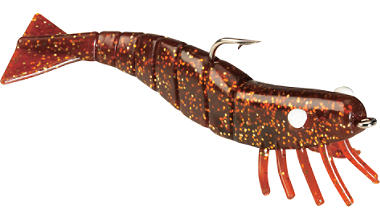 DOA
Shrimp, 3 inch; We are going to
round out our selection lures by
including some soft plastic lures,
starting with one of the better newer
lures around, the
3 inch DOA Shrimp. For years I have
seen some variation of plastic shrimp on
the market and they were all pretty much
worthless. The DOA Shrimp is the first
exception I have come across. While
imitating the look of a shrimp in
plastic is easy, the DOA is by far the
most realistic when it is most
important, in the water. It actually
looks like a shrimp swimming when
retrieved slowly with an occasional
twitch. This is due to the small weight
inserted into each body. It rides with
the hook upright to reduce snagging and
It comes in packages of three. Get one
package each of the three inch model in
chartreuse with silver glitter and the
root beer with gold glitter. DOA
Shrimp, 3 inch; We are going to
round out our selection lures by
including some soft plastic lures,
starting with one of the better newer
lures around, the
3 inch DOA Shrimp. For years I have
seen some variation of plastic shrimp on
the market and they were all pretty much
worthless. The DOA Shrimp is the first
exception I have come across. While
imitating the look of a shrimp in
plastic is easy, the DOA is by far the
most realistic when it is most
important, in the water. It actually
looks like a shrimp swimming when
retrieved slowly with an occasional
twitch. This is due to the small weight
inserted into each body. It rides with
the hook upright to reduce snagging and
It comes in packages of three. Get one
package each of the three inch model in
chartreuse with silver glitter and the
root beer with gold glitter.
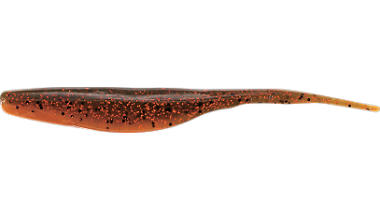 Saltwater
Shad Assassin; 5 inch; Made by Bass
Assassin, rig them weedless with a size
2/O plastic worm hook and attach to
your leader with a rapala or mirrolure
loop knot without additional weight.
These lures will sink slowly and can be
fished in very shallow seagrass flats,
or under mangrove trees. Provide a very
slow retrieve by twitching the rod tip
slightly and resting, using the reel
only to reel up the excess slack in the
line. The lure will dart upward and to
one side, then sink slowly imitating a
stunned or dying minnow. This triggers
strikes from gamefish who by their
nature will always go after the easiest
meal possible. Using this lure has saved
to day for me when nothing else has
worked, especially around the culverts
of Merritt Island National Wildlife
Refuge when the water is flowing through
them from the impoundments into waters
connected to the lagoon. Saltwater
Shad Assassin; 5 inch; Made by Bass
Assassin, rig them weedless with a size
2/O plastic worm hook and attach to
your leader with a rapala or mirrolure
loop knot without additional weight.
These lures will sink slowly and can be
fished in very shallow seagrass flats,
or under mangrove trees. Provide a very
slow retrieve by twitching the rod tip
slightly and resting, using the reel
only to reel up the excess slack in the
line. The lure will dart upward and to
one side, then sink slowly imitating a
stunned or dying minnow. This triggers
strikes from gamefish who by their
nature will always go after the easiest
meal possible. Using this lure has saved
to day for me when nothing else has
worked, especially around the culverts
of Merritt Island National Wildlife
Refuge when the water is flowing through
them from the impoundments into waters
connected to the lagoon.
 To
rig the above bait weedless use the same
hook freshwater fishermen use for
plastic worms for bass fishing. the
point of the hook is driven into the
from of the nose of the bait until the
first curve after the barb, then turn
the hook downward and exit the lure.
Turn the hok in the lure point up so
that you can reinsert the hook into the
belly of the lure. You want the point to
end up just under the top sruface of the
lure without distorting the overall
shape of the lure. To
rig the above bait weedless use the same
hook freshwater fishermen use for
plastic worms for bass fishing. the
point of the hook is driven into the
from of the nose of the bait until the
first curve after the barb, then turn
the hook downward and exit the lure.
Turn the hok in the lure point up so
that you can reinsert the hook into the
belly of the lure. You want the point to
end up just under the top sruface of the
lure without distorting the overall
shape of the lure.
 Here
(roughly, very roughly) is the path the
worm hook should follow in the shad
assasin for best results. In this way
the body of the hook outside of the lure
hangs below the lure, meaning the lure
will ride upright when in the water.
This will be completely weedless and can
be fished effectivly over thick grass in
shallow flats. When setting the hook on
a strike be sure to set the hook hard
enough to come out of the body of the
bait and stick in the mouth of the fish.
Just a bit harder than normal, as you
certianly don't want to break the line. Here
(roughly, very roughly) is the path the
worm hook should follow in the shad
assasin for best results. In this way
the body of the hook outside of the lure
hangs below the lure, meaning the lure
will ride upright when in the water.
This will be completely weedless and can
be fished effectivly over thick grass in
shallow flats. When setting the hook on
a strike be sure to set the hook hard
enough to come out of the body of the
bait and stick in the mouth of the fish.
Just a bit harder than normal, as you
certianly don't want to break the line.
 Snap
swivels; These are designed to do
two things, allow quick and easy
changing of lures or hooks and to reduce
twisting of your line that certain lures
will cause. I rarely use them,
preferring to use a Rapala Knot to
attach most lures to my leader. The only
exception to the above list of lures is
the Johnson's Silver Minnow as the lure
does twist a lot and has no swivel
attached to the front end. Snap
swivels; These are designed to do
two things, allow quick and easy
changing of lures or hooks and to reduce
twisting of your line that certain lures
will cause. I rarely use them,
preferring to use a Rapala Knot to
attach most lures to my leader. The only
exception to the above list of lures is
the Johnson's Silver Minnow as the lure
does twist a lot and has no swivel
attached to the front end.
Tackle for fishing with Bait
But first, a word about the baits
themselves.
Jump to;
Lures |||
Back to Top
Live Baits
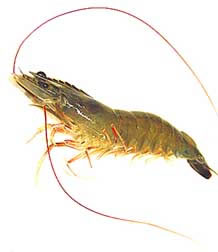 Live
shrimp is by far the most popular live
bait in use around here and is available
in most tackle shops. Other popular
baits are live finger mullet, about
three to six inches in length and in the
summertime, live pigfish. I fish live
baits primarily with two rigs with as
little terminal tackle as possible. The
first rig is called a freeline rig,
which is just a hook tied to my leader
with no other tackle, and a float rig
where I use a float to suspend a live
bait just above the tops of the
seagrasses as Shrimp, Mullet, and
Pigfish will attempt to hide from
gamefish in the grasses. About the only
time I will use a weight is when there
is a current in a deeper are such as
Haulover Canal on Merritt Island
National Wildlife Refuge, and I want to
get a live shrimp near the bottom. Live
Shrimp can also be used on jig heads and
complete jigs and worked as a lure, just
hook the shrimp from the chin
upwarduntil the point of the hook comes
out the top of the head. Be careful to
miss the dark spot. That's the brain and
will kill the shrimp. Live
shrimp is by far the most popular live
bait in use around here and is available
in most tackle shops. Other popular
baits are live finger mullet, about
three to six inches in length and in the
summertime, live pigfish. I fish live
baits primarily with two rigs with as
little terminal tackle as possible. The
first rig is called a freeline rig,
which is just a hook tied to my leader
with no other tackle, and a float rig
where I use a float to suspend a live
bait just above the tops of the
seagrasses as Shrimp, Mullet, and
Pigfish will attempt to hide from
gamefish in the grasses. About the only
time I will use a weight is when there
is a current in a deeper are such as
Haulover Canal on Merritt Island
National Wildlife Refuge, and I want to
get a live shrimp near the bottom. Live
Shrimp can also be used on jig heads and
complete jigs and worked as a lure, just
hook the shrimp from the chin
upwarduntil the point of the hook comes
out the top of the head. Be careful to
miss the dark spot. That's the brain and
will kill the shrimp.
 Mullet
are great bait for Trout, Redfish,
Snook, Tarpon, and many other species
within the lagoon, and each summer into
fall become the primary species of
forage for these gamefish. They can be
hooked on a 2/0 hook either through the
upper lip, (cast very gently) or through
the back between the two fins. Take care
to avoid the spinal column which is
along the lateral line. Mullet
are great bait for Trout, Redfish,
Snook, Tarpon, and many other species
within the lagoon, and each summer into
fall become the primary species of
forage for these gamefish. They can be
hooked on a 2/0 hook either through the
upper lip, (cast very gently) or through
the back between the two fins. Take care
to avoid the spinal column which is
along the lateral line.
Dead Baits
Go into almost any tackle shop in
Florida and you will find a selection of
frozen baits for sale, including shrimp,
whole finger mullet, cut mullet, sand
fleas, clams, squid, etc. Many fish
species will eat pretty much any of
these although fresh is by far better.
The most popular of these are the mullet
baits and I reccomend these if going
after any of the lagoon big four
(redfish, seatrout, snook, and tarpon.)
It has been my experience that seatrout
are more of an ambush predator and are
more likely to take a moving bait rather
than a dead bait just lying on the
bottom or suspended under a bobber. In
fact on more occasions than I can count,
while fishing for seatrout with live
shrimp, I have been in the middle of a
bite when suddenly all action stopped.
Upon reeling in to check my bait, I've
found the shrimp had died on the hook,
replaced it with a fresh live shrimp and
resumed catching trout immediately.
However if using a dead finger mullet
hooked through the nose you can twitch
it like a lure and they will hit it.
I've rarely been able to do this with
dead shrimp. Redfish are basically hogs
and will eat almost anything edible they
come across. Snook and tarpon will also
occasionally grab a dead bait they come
across. Unfortunately, so will saltwater
catfish which is one reason I don't use
cut bait all that often.
Bait Fishing Tackle
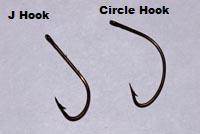 Hooks;
Obviously the most important thing
to tie on your line is a hook. I use
Circle Hooks and strongly recommend
them. If used properly they will almost
always hook a fish in the corner of the
mouth rather than gut or gill hooking,
allowing a successful catch and release.
With a traditional "J" hook, you set the
hook with a sharp pull of the rod when
the fish takes the bait and the hook
would grab the first thing it contacted
or pull out of the fishes mouth. If the
fish had already swallowed the bait it
would hook them in the gut or would
sometimes hook them in the gills,
effectively killing the fish even after
you released it. With a circle hook, you
don't set the hook with a sharp pull of
the rod or it will not likely hook the
fish. To set a circle hook provide a
steady tension to the line by holding
the rod tip upward and reeling until you
feel the fish on, then fight it to shore
like you normally would. Here's how a
circle hook works. When a fish takes and
begins to swallow the bait it will not
likely be facing directly towards you
and will start to swim away. Steady
tension on the line will pull the hook
safely past the gills and to the corner
of the mouth. Once the hook reaches the
corner of its mouth, the circular design
of the hook's shank will cause the point
of the hook to rotate and imbed itself
in the corner. In this way the hook can
be easily removed without any real harm
to the fish and I have also noticed a
much higher hookup ratio. For live
shrimp I use an
Eagle Claw Lazersharp Size 1/O to 2/O
Circle Hook in bronze finish hooked
just under the clear spot right under
the horn of the shrimp's head or
occasionally I will place the hook
horizontally near the base of the tail.
For live mullet I will use an
Eagle Claw Lazersharp Size 2/O or 3/O
Circle Hook, depending on the size
of the bait. Insert the hook near the
tail just behind the dorsal fin above
the lateral line. Pigfish can be hooked
the same way but many people will hook
them underneath near the anus. Fished
under a popping cork over grass flats,
you can pull the popping cork which
tends to make the pigfish turn upside
down momentarily at which point it will
emit a grunting noise (hence the name
pigfish) and attract the attention of
large seatrout. Hooks;
Obviously the most important thing
to tie on your line is a hook. I use
Circle Hooks and strongly recommend
them. If used properly they will almost
always hook a fish in the corner of the
mouth rather than gut or gill hooking,
allowing a successful catch and release.
With a traditional "J" hook, you set the
hook with a sharp pull of the rod when
the fish takes the bait and the hook
would grab the first thing it contacted
or pull out of the fishes mouth. If the
fish had already swallowed the bait it
would hook them in the gut or would
sometimes hook them in the gills,
effectively killing the fish even after
you released it. With a circle hook, you
don't set the hook with a sharp pull of
the rod or it will not likely hook the
fish. To set a circle hook provide a
steady tension to the line by holding
the rod tip upward and reeling until you
feel the fish on, then fight it to shore
like you normally would. Here's how a
circle hook works. When a fish takes and
begins to swallow the bait it will not
likely be facing directly towards you
and will start to swim away. Steady
tension on the line will pull the hook
safely past the gills and to the corner
of the mouth. Once the hook reaches the
corner of its mouth, the circular design
of the hook's shank will cause the point
of the hook to rotate and imbed itself
in the corner. In this way the hook can
be easily removed without any real harm
to the fish and I have also noticed a
much higher hookup ratio. For live
shrimp I use an
Eagle Claw Lazersharp Size 1/O to 2/O
Circle Hook in bronze finish hooked
just under the clear spot right under
the horn of the shrimp's head or
occasionally I will place the hook
horizontally near the base of the tail.
For live mullet I will use an
Eagle Claw Lazersharp Size 2/O or 3/O
Circle Hook, depending on the size
of the bait. Insert the hook near the
tail just behind the dorsal fin above
the lateral line. Pigfish can be hooked
the same way but many people will hook
them underneath near the anus. Fished
under a popping cork over grass flats,
you can pull the popping cork which
tends to make the pigfish turn upside
down momentarily at which point it will
emit a grunting noise (hence the name
pigfish) and attract the attention of
large seatrout.
Floats and Bobbers; Almost any
bobber or float can be used to suspend a
shrimp or pigfish at a desired depth. A
very popular version here is called a
popping cork. Usually these are made of
styrofoam and will have a slit in the
side cut in the side and a peg to secure
the cork to the line. they will also
usually be weighted a bit to increase
casting distance and make them float in
an upright position. An occasional
twitch of the cork with the rod tip will
produce a popping noise which attracts
nearby gamefish, especially seatrout.
You can also use these over artificial
jigs with a popping retrieve.
Sinkers; I rarely use sinkers in the
lagoon as most of the water I fish is
fairly shallow or I am using lures most
of the time anyway. But there are
occasions where I will use a small
sinker to get a shrimp down to deeper
depths, especially when I am fishing a
place that has a current in it like
Haulover Canal on Merritt Island
National Wildlife Refuge near
Titusville. When I fish there I am not
trying to get a rig to stay in one place
on the bottom ust trying to drift a live
shrimp into the depths so I can cast
upstream and let it drift back. I carry
a small box of reuseable split shot that
can be applied by finger pressure alone.
These have little fins by which the shot
can be removed from the line by
compressing them together. Care must be
taken not to compress split shot on the
line too tightly as it can compromise
your line strength. I attach them with
finger pressure above the leader as the
knot will prevent them from sliding down
to the hook.
A Few Other Essentials
Tackle Bag; Obviously by now you
need some way of carrying all this stuff
around and the one thing I hate is to
carry tackle with me that I won't need
for that particular trip when fishing.
If I'm fishing saltwater in the lagoon,
I don't want to carry surf or freshwater
equipment. I also do a lot of shoreline
fishing out on the Merritt Island
Wildlife Refuge and when I do there are
dike roads that I will walk a
considerable distance along as I fish
and I hate having to constantly pick up
and move a hard tackle box. For this
reason I like a softsided tackle bag
just big enough to carry my equipment
that has a shoulder strap. I am
currently using a
Plano model 4450 Softsider that
carries four
3500 Series ProLatch Utility Boxes.
This will carry all of the tackle in
this article with room for a bit more.
In this way my tackle stays with me
everywhere I go. The primary advantage
of soft sided tackle bages is that at
least with Plano, extra utility boxes
are readily available, cheap, and you
can have separate utility boxes for
other types of fishing and simply switch
out the boxes for the day's fishing. One
additional thing I love about about this
particular bag is that it has two velcro
straps designed to secure the bag to the
center thwart of a canoe which I do fish
out of occasionally. It will also attach
to the handlebars of a mountain bike.
With the Refuge having some litter and
vandalism problems some areas previously
accessible by motor vehicle are being
closed to vehicles and marked as bicycle
and hiking access only.
Multi-Tool; Manufactured by
Leatherman, Gerber, Victorinox (makers
of Swiss Army Knives), and many other
companies, this tool combines a pair of
needlenosed pliers with at least 1 knife
blade and makes a great addition to your
fishing gear. Can be used to remove
hooks from fish, cut leader material and
trim the excess tag line (the part of
the line that sticks out from a fishing
knot not attached to the reel). These
usually have screwdriver as well which
can be used to perform minor reel
repairs in the field. I consider either
this or a pair of pliers and a
pocketknife essential tools to carry
with you with the multi-tool having the
advantage of carrying an entire tool kit
in one piece of gear. Carry this in a
separate pocket in your tackle bag and
it will allways be there no matter what
lure boxes you carry.
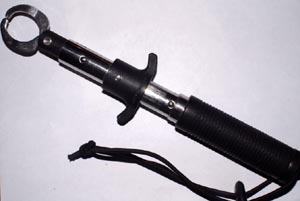 Boga
Grip; In my opinion the greatest
thing to ever happen to fishing outside
of the rod and reel. This device is
essintially a pair of hooked jaws that
open when you pull back on a trigger
mechanism that you then use to pick up
or land a fish by grasping a fish by
it's bottom jaw. You can then remove the
hook, weigh the fish, take pictures, and
release it without ever having to touch
the fish with your hands. This prevents
removal of the fishes slime coat, which
protects the fish from infections. It
can also protects you from getting a
hook in your hand, getting bitten by
toothy species and from getting finned
by fish with spiny fins such as catfish
while giving you complete control of the
fish from landing until release. It will
also protect you from ever having to
wash fish slime from your hands in cold
water in the winter. Using one of these
is better for both you and the fish. The
actual
Boga Grip is made by Eastaboga Tackle
Company (www.bogagrip.com) while
Rapala has it's own version called the
Rapala ProGuide Lock and Weigh
(www.rapala.com).
Available is several sizes ranging from
freshwater use to large units for
deepsea fishing. If buying one for
lagoon use, get the one rated for about
20 to 30 lb fish. Use the jaws to clip
it to the strap of your tackle bag and
it will be there when you need it. Boga
Grip; In my opinion the greatest
thing to ever happen to fishing outside
of the rod and reel. This device is
essintially a pair of hooked jaws that
open when you pull back on a trigger
mechanism that you then use to pick up
or land a fish by grasping a fish by
it's bottom jaw. You can then remove the
hook, weigh the fish, take pictures, and
release it without ever having to touch
the fish with your hands. This prevents
removal of the fishes slime coat, which
protects the fish from infections. It
can also protects you from getting a
hook in your hand, getting bitten by
toothy species and from getting finned
by fish with spiny fins such as catfish
while giving you complete control of the
fish from landing until release. It will
also protect you from ever having to
wash fish slime from your hands in cold
water in the winter. Using one of these
is better for both you and the fish. The
actual
Boga Grip is made by Eastaboga Tackle
Company (www.bogagrip.com) while
Rapala has it's own version called the
Rapala ProGuide Lock and Weigh
(www.rapala.com).
Available is several sizes ranging from
freshwater use to large units for
deepsea fishing. If buying one for
lagoon use, get the one rated for about
20 to 30 lb fish. Use the jaws to clip
it to the strap of your tackle bag and
it will be there when you need it.
Good Luck!
Dean Pettit
|